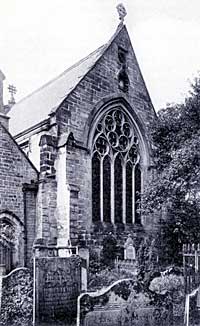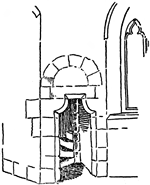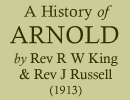< Previous | Contents | Next >
The Parish Church.

Arnold church.
There is no reference to the Church in Domesday Book, but that must not be taken to indicate that it did not exist when the Survey was made (1086). The Commissioners for this part of the country seem to have confined their attention to estates that yielded payment to the Crown; and even in respect of an important ecclesiastical centre like Southwell the Church is not mentioned at all. We can therefore only surmise that a pre-Norman edifice once occupied the site, but we have no means of ascertaining, even approximately, when it was built. The village feast is still held on the first Sunday after the 19th of September, and this gives a clue to the early dedication; for the 19th of September corresponds with the day set apart in the calendar according to the old style1 for commemorating the Nativity of the Virgin (September 8th). It seems probable therefore that the original dedication would be, not simply to St. Mary, as at present, but to "love the Nativity of the Virgin Mary; "just as the dedication of the neighbouring forest Church at Blidworth was to St. Mary at Her Purification (February 2nd).
The oldest portion of the existing Church is the wall of the North Aisle. If we may rely upon the tracery of the windows, which are modern restorations, being anything like a copy of the original work, it would be safe to date this portion back to the latter part of the 13th century (c. 1270). But there must have been a Church here a century earlier than this, for it is recorded on page 235 of "Thoroton's History of Notts." (published 1677), that "William de Belew, son of Robert de Belew, who married Alice the daughter of William de Arnal, gave her in Dower at the Church door before marriage, all his land in Lamcote." (22 Henry ii [1176] ?). From this extract we may learn two things:—
- That a Church was in existence here at least 100 years before any of the present stones were set up.
- The intimate connection between the Church and the life of the community: for all legal business was transacted in the Church porch; even the legal part of the marriage contract was entered into at the Church door, the blessing being afterwards given before the Altar.
" Husbands at the Church door had she five."
(Chaucer—"Wife of Bath.")

Arnold church, east end.
The following extract from the Torre MS. shews that the Church was by this time in the patronage of the Priory of Launds2— a Priory of Black Canons of the Order of St. Augustine, situate near the village of Lodington (Loteyngton), on the Rutland border of the County of Leicester, 14 miles from Leicester, 7 miles from Uppingham, and 5 miles from Oakham.
"The Church in Ernehale was given by King Henry II. to the Priory of Lande in Com. Leicester, which had from that time a Rectory of the patronage of those Canons who received out of it the annual pension of 3 marks till 2nd August, 1408," &c, &c. The greater portion of the present Church was built, as we shall see, under this patronage, when John de la Launde was the Vicar (1315—1347).
These scattered fragments of history, in conjunction with the ancient architecture, will enable us to trace, with some degree of accuracy, the developments which have taken place from time to time.
There can be little doubt that Arnold grew in much the same way as many other English villages have done. First a clearing was made in the woodland to make room for the habitations of a primitive community ("In Ernehale King Edward had woodland for pannage scattered, three leagues in length and three in breadth."— Domesday Book).
In close proximity to the dwellings a little Church was erected, having wooden walls made from the "okes of Shirewood," halved and set upright with their split faces inwards, and surrounded by an enclosed grave yard. By and by an addition was made to the Church in the shape of a sturdy bell tower at the west end. As this tower had to serve also as a fortress to protect the village community in times of peril, it was built of stone; the material being quarried near the site from the beds of sandstone of the lower Keuper, or "water stones" which underlie the clay in this district. When the Normans took possession of the land they gradually replaced the wooden walls with masonry, so that by the time the wedding took place between Robert de Belew and Alice, daughter of William de Arnal, when the Church is mentioned for the first time in history, the building would in all probability consist of a sturdy square tower with a western doorway, a small nave without aisles, a chancel of the same width as the nave and communicating with it through a narrow opening crowned with a low semi-circular arch; the whole dimly lighted by narrow round-headed windows. This, however, is all conjecture, as not a vestige of the work of this early period remains.
An extension appears to have been made a century later when aisles were thrown out on either side, and here we leave conjecture and come into contact with facts, for the walls of the present north aisle are the actual work of the 13th century. We have recently had proof that this aisle was built in extension of an existing building, for when the Church was repaired in 1868-9 a trench was dug alongside the North wall, which had given way, in order to get it back to an upright position. The discovery was then made that a portion of the ancient graveyard had been taken in, for this wall was built over a row of graves, each containing an uncoffined skeleton, and as no foundation work appertaining to a former structure was found, it is a fair conclusion that, in this case, as in so many others, the Church was enlarged by building new side walls so as to form aisles.
Towards the close of the 13th century a movement set in throughout the country for enlarging and beautifying village churches, so as to make them more suitable for the elaborate ritual then in use. The Church at this time was under the patronage of the Augustinian Canons of the Priory of Laund. In 1315, one of their number, John de la Laund, was appointed to be Vicar (for Regular Canons were not bound to manual labour, and unlike the monks "they were allowed in individual cases to serve the parishes that were impropriated to their houses."8) During the latter part of his Vicariate he appears to have called to his aid a peripatetic band of craftsmen who had gained great notoriety in the county by their skill in building. Fine examples of their work may still be seen in the chancels of Woodboro', Car Colston, Sibthorp, and Hawton—to mention only a few Churches in the immediate neighbourhood,—and by comparing the details we know that the Church at Arnold was also built by them. The work was commenced circa 1340, and if we may judge by the small portion still left at the east end the design produced was worthy to be compared with any Church in the county. The old Church was swept away with the exception of the North aisle, which was repaired, fitted with new windows, and incorporated in the new work. A few fragments of moulded and incised stonework belonging to an earlier Church, together with some ancient grave-covers, were re-used in building the new walls. I think it is probable that in conformity with ancient custom they commenced to build at the east end and completely re-built the chancel before the old nave was pulled down. I am aware that many authorities say that the nave is earlier work, but I can find nothing to support this statement—in fact the evidence all points the other way. For instance, the original floor-line of the chancel was below the floor line of the nave. If you look at the position of the sedilia on the south side and the founder's tomb on the north side, and notice the pseudo bases to the responds of the chancel arch (which are only modern adaptations made to suit the altered floor level,—the original base mouldings being presumably buried below the pavement), it is obvious that the chancel floor as we see it now has been subsequently raised to suit the level of the nave.
This proves to my mind that the chancel was completed and in use for some time before the re-building of the nave was commenced. Why the new floor level of the nave was fixed so much above the natural ground is not now apparent. It certainly proved to be a factor in the destruction of the Church, for when the work of restoration was in progress in 1868-9 the walls and piers were found to be out of upright, and before they could be straightened the ground had to be excavated and the foundations underpinned to a depth of nine feet.
There could not have been a great lapse of time however between the commencement and completion of the whole of the work, as a comparison of the mouldings and ornaments will show, but I think we may safely say that the chancel is older than the nave.

It will be noticed that the nave arcade consists of five bays, but it is clear from the variation in the width of the openings, and the change in the contour of the mouldings that the 14th century arcade was only three bays in length (the usual arrangement for a village Church), and that the two western-most bays were added at a subsequent date, perhaps when the tower was re-built (circa 1450). The original western responds were evidently taken down and re-built in the altered position, as they correspond with those at the eastern end. The narrow arches on either side, at the eastern end of the arcades are modern, having been cut through the walls since the removal of the rood-loft, which presumably stretched across from wall to wall, in front of the chancel arch. A circular staircase or "vyse," skilfully contrived in the respond, formed the approach to the loft; the position of the upper doorway, now blocked up with masonry, is clearly visible in the wall above. The staircase is in a good state of preservation and forms an interesting link with the past. We can imagine with what reverential feelings acolytes of old ascended these stairs in order to trim the lights which were kept burning before the images, and also along the front of the screen; or to veil the representation of the Crucified which stood in the centre of the loft, between Mary the Mother and St. John; or to ring the sacring bell to apprise the kneeling worshippers in the nave at the most solemn moments in the Service of the Mass.
In accordance with pre-Reformation custom the east end of either aisle was screened off to form chantry chapels, each fitted with an altar with all the accessories. Stretton says that four chantries were once contained within this Church, and this may probably have been so. The screens and the altars have all been destroyed; the only trace left is a double piscina in the wall on the south side which was brought to light when the stucco was removed from the walls of nave and aisles in 1905. This probably indicates the position of the chapel of St. Katharine.4 The removal of the stucco has not only brought the piscina to light, it has also revealed the ancient stonework. The jambs and rear-arches of the windows are the work of the 14th century, but the mullions and tracery are modern, and at best but a spiritless copy of the old work. A fragment of tracery belonging to one of the old windows is still in situ in the north wall of the chancel, above the opening into the organ chamber, and it needs no words to tell how much better in every way the old work was in comparison with the new. The whole of this three light window-head appears to have been hewn out of one piece of stone: a practice not uncommon where good blocks of stone could be obtained.
The pulpit is modern, the gift of Colonel Welfitt.
